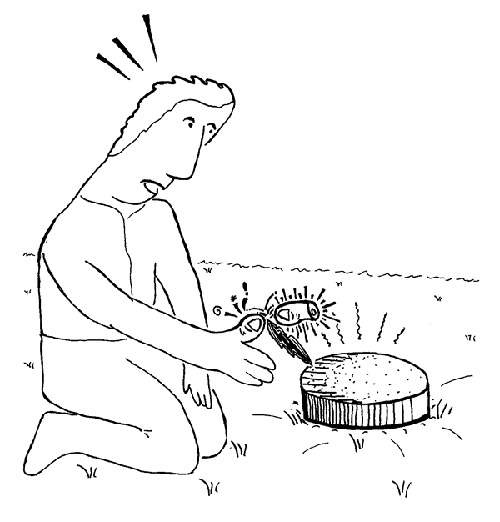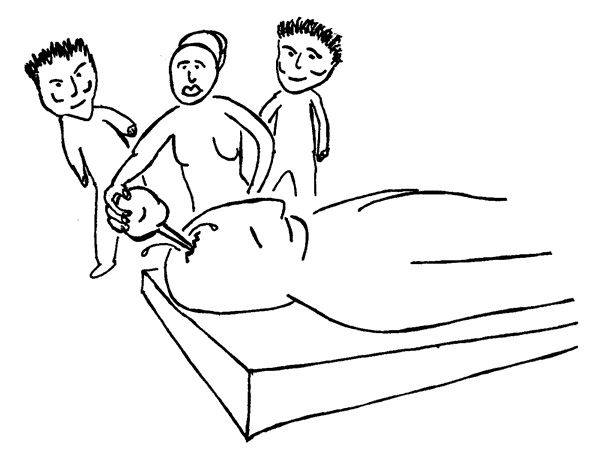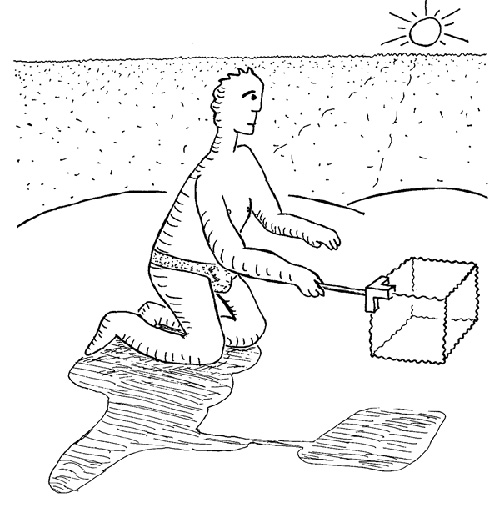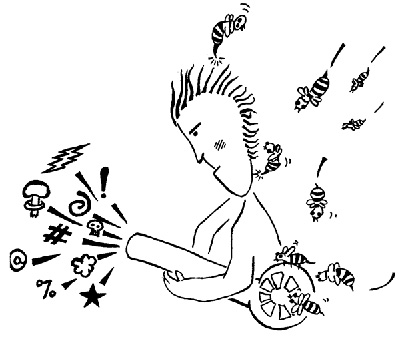I’m thinking about having some direct matter control in Hylozoic. I’ve written about this before, calling it femtotechnology. It was in Freeware first, and then I worked out the science for it in Saucer Wisdom. Here’s a long quote about femtotech from Saucer Wisdom, a scence featuring my old characters Harry Gerber and Joe Fletcher.

[Begin quote from Saucer Wisdom.]
We’re early in the year 3001, looking in on the founder of femtotechnology, a dumpy guy with thick lips and a slobbering way of talking. He’s telling his plans to a tall skinny assistant who has a little tuft of curly hair. Their names are Harry and Joe.
“We’re going to invent femtotechnology now,” sloppy Harry is saying. “To make a long story short.”
“Say what?” says curly-top Joe.
“I’ll explain it again,” says Harry. “First of all, here’s the official prefixes for small numbers.” A radiotelepathically projected chart appears in the minds of Harry, Joe, and the eavesdropping Frank.
Name *** Numerical Symbol *** Prefix
Thousandth *** 0.001 *** Milli-
Millionth *** 0.000001 *** Micro-
Billionth *** 0.000000001 *** Nano-
Trillionth *** 0.000000000001 *** Pico-
Quadrillionth *** 0.000000000000001 *** Femto-
Quintillionth *** 0.000000000000000001 *** Atto-
Sextillionth *** 0.000000000000000000001 *** Zepto-
Septillionth *** 0.000000000000000000000001 *** Yocto-

“Yawn yawn, I’ve seen that,” says Joe.
“Seen but not understood,” says Harry. “To grasp the meaning of the word ‘femtotechnology,’ you should first think about the word ‘nanotechnology.’ A nanometer is a billionth of a meter. An big molecule might be ten or twenty nanometers across, maybe a little more. A water molecule is smaller, about a fifth of a nanometer. Nanometers are a natural size-unit for measuring molecules, so when people developed the technology for manipulating molecules they called it nanotechnology.”
“Then how come the dooks who work with molecules say they’re doing wetware engineering?” asks Joe.
“That’s a historical accident,” says Harry. “The original nanotechnologists — we’re talking about nearly a thousand years ago — thought they were going to be making tiny machines. But that idea turned out to be bogus. Biology has the lock on nanometer-scale fabrication. The word ‘nanotechnology’ died because the first guys to use it had some wrong ideas. It’s sort of like the way the alchemists thought substances had philosophical virtues, and then a few centuries later it turned out they’d been trying to do chemistry. The old-time nanotechnologists thought molecules were like machines, and then a few centuries later it turned out they’d been trying to do wetware engineering. Nobody wants to be branded an alchemist or a nanotechnologist because those original groups were wrong in important ways. But my point, Joe, is that wetware engineering is indeed nanotechnology. It’s what’s going on when you use medi-germs to clean out your arteries. It’s what’s happening when a diamond-spider spins carbon fibers for construction. It’s what happens when a cloth-plant weaves cellular automaton fabric for your shirts.”
“Don’t hurt yourself, man,” says Joe. “You’re explaining too hard. Try this one: according to the chart, picotechnology should come before femtotechnology. Why don’t we do picotechnology first?”

“There isn’t much happening at the picometer size scale,” says Harry. “The next really solid thing below molecules is the nucleus of an atom. And that turns out to be about twenty femtometers. So if we start doing things directly to atomic nuclei we’re talking about femtotechnology. There isn’t going to be any picotechnology because there’s nothing interesting that’s a picometer in size.”
“Very clean,” say Joe. “Femtotechnology. I’m down with it, brah. But what are we going to do to the atoms?”
“Transmute them, Joe. Dirt into gold. Gold into water. Water into air. Air into chicken soup. Making stuff out of ‘thin’ air is quite practical, you know. Air has more mass than people realize. A cubic meter of it weighs a kilogram. The air in your bedroom weighs about as much as your body.”
“But how does transmutation work?”
“Transmutation is mostly a matter of changing protons into neutrons and vice-versa. An atom’s nucleus is a bunch of protons and neutrons. Take oxygen, it’s got eight neutrons and eight protons. And hydrogen has one proton. If you could change protons into neutrons, you could stick sixteen hydrogens together, flip half of their protons to neutrons and you’d have a molecule of oxygen. Like that. And by the way, when you change the nuclei, the electrons take care of themselves.”
[Here’s an amazing video of femtotech transmuatation from the far-out video site Flight 404.]
“But how do you change a proton into a neutron? Smash it or something?”
“That’s the crude old nuclear physics way. Instead of that, we femtotechnologists are going to use quark-flipping. Takes much less energy. What’s quark-flipping? A proton is a quark-bag holding two up quarks and one down quark, while a neutron is a quark-bag with two down quarks and one up quark. To change from one to the other, you just need to go into the bag and flip the one quark.”
“Aren’t there other kinds of quarks, too?” asks Joe. “Besides up and down?”
“Strange quarks,” says Harry, smiling wetly. “We’ll get to those later, my man. But first we need to get the femtotechnology matter transmuter working.”

“What do you want to call it?”
“I don’t know,” says Harry. “Horne O’ Planty? Spelled weird to make it a trademark, you understand. Or maybe a Polish Knife? My mother’s people are Polish. Or call it an alef? Or maybe a cradle or a loom?”
“How about an alla,” says Joe.
“I like it,” says Harry after a moment’s thought. “Alla. Fine. Now what’s still missing, Joe?”
“How to make it work is what’s missing.”
“Incommensurable magnitudes,” says Harry. “We’ll use three titanium bars of slightly different irrational lengths. The square root of two, the cube root of three, and the fifth root of five will work. Each bar will have a matter-lens that grows quark whiskers, and the whiskers will embody a one-dimensional nonlinear wave pattern that tells them where to turn. The whiskers will split and grow along all the edges of a parallelopiped control volume. Within this box we’ll use a chaotic cascade to fuse all the nucleons’ quark-bags into a quark-gluon plasma that we’re free to flip, shuffle and regroup. The process will be directed by high-level user request patterns made via a custom-designed radiotelepathic uvvy which incorporates low-level implementation instructions for a few thousand basic substances. You can help with that part, Joe. And in our commercial release, the control uvvy can act as a carrying case. The alla!”
“Wavy,” says Joe. “I’m there, dude.”
[End quote from Saucer Wisdom.]

I want some cool weapons. I need to think of what they do and give them fairly simple names.
The stonker. The target gets cold and frosty then falls apart. Could be that it damps atomic vibrations or, funnier, the atomic silps are too stoned to hold together—Sonic mentions a thing like this in Chap 1. Not sure of the name of this weapon. Devibrilizer looks too much like “devil.” Vibrilizer is backwards. Nuller sound Star Trek. Stonker. I like stonker, it sounds like stoner, stomper, stink and stalk.
The klusper. Amps up atomic vibes, overloads the atoms with Gaian information flow, they heat up and explode into plasma. Klusper like crisper.
The gobble gun. Looks like a hollow barber pole. Is always sucking some air in front and sending it out the back. Crank it up to full power, and it inhales everything in front of it, empties out a cylindrical tube about a kilometer long and a meter wide, turns the matter into a tidy black coil of degenerate-matter in back, like the sh*t-vein of a shrimp. At first I wanted to call it the gomper gun, which sounds funnier, gomper like gopher and Gomer. But gobble gun is so much easier to understand.










February 24th, 2008 at 4:46 pm
Hello Rudy! It is good to see your blog. I have been a fan of you for some time. I have Saucer Wisdom, the Free Ware books, White Light, your book on Infinity, the book you wrote on the Fourth Dimension, and even your latest about the NANTS!
I am very interested in nanotechnology, biotechnology, femtotechnology, UFO science, and how we can make the world a better place for people with advanced clean technologies while not destroying each other.
Please keep me up to date on any new books you have coming out. I’m a definite customer.
I was pondering earlier how in one sense everything is mechanical, even things we call energetic like radiation and electromagnetism, because they are assemblies of particles and things interacting mechanically. Yet things are also energetic, even matter. I also like what you have pointed out before: Nanotech is faced with a chicken and egg problem, we can design dry nanotech but cannot build it, and we can build wet nanotech but cannot design it.
Take care